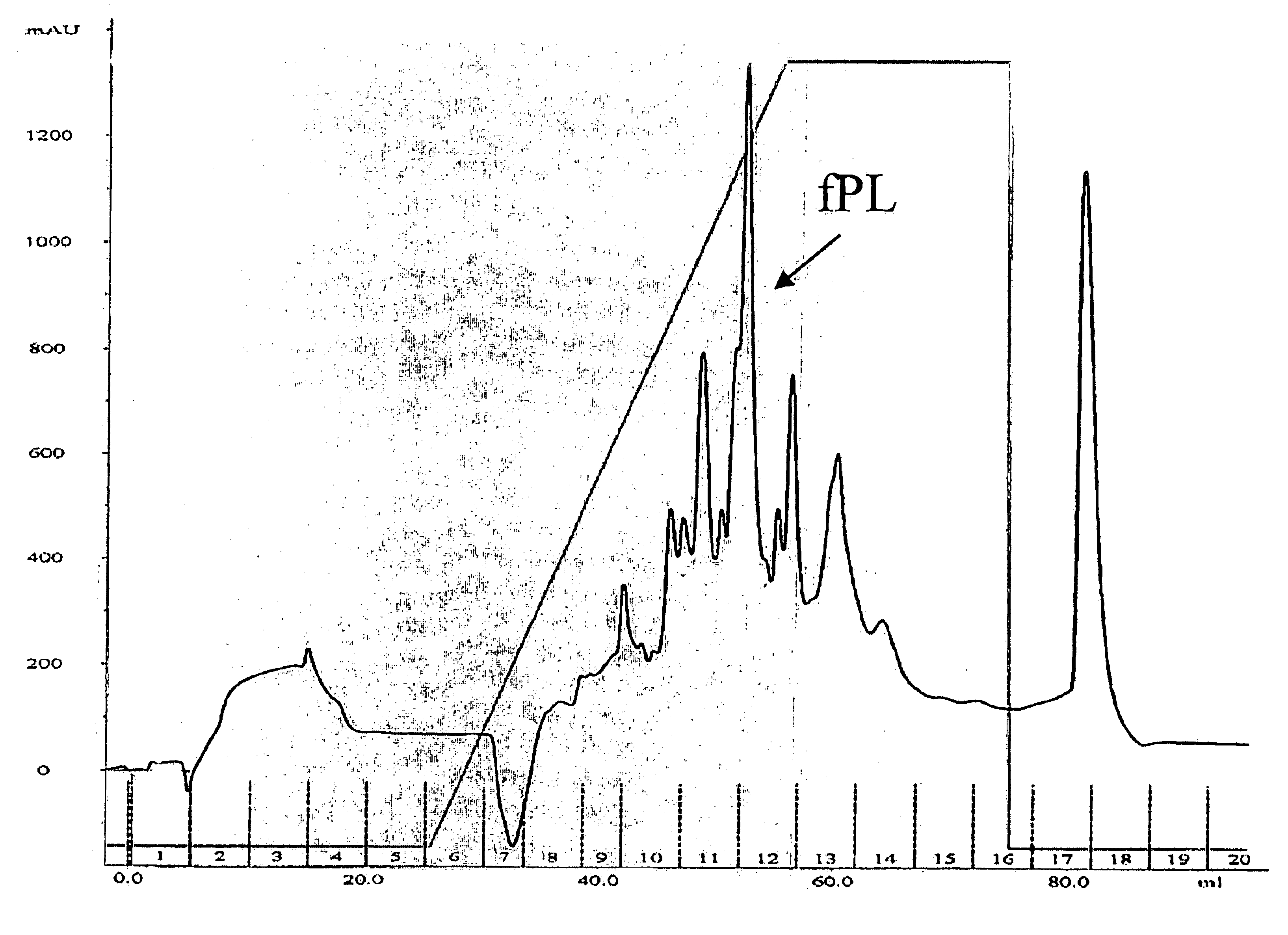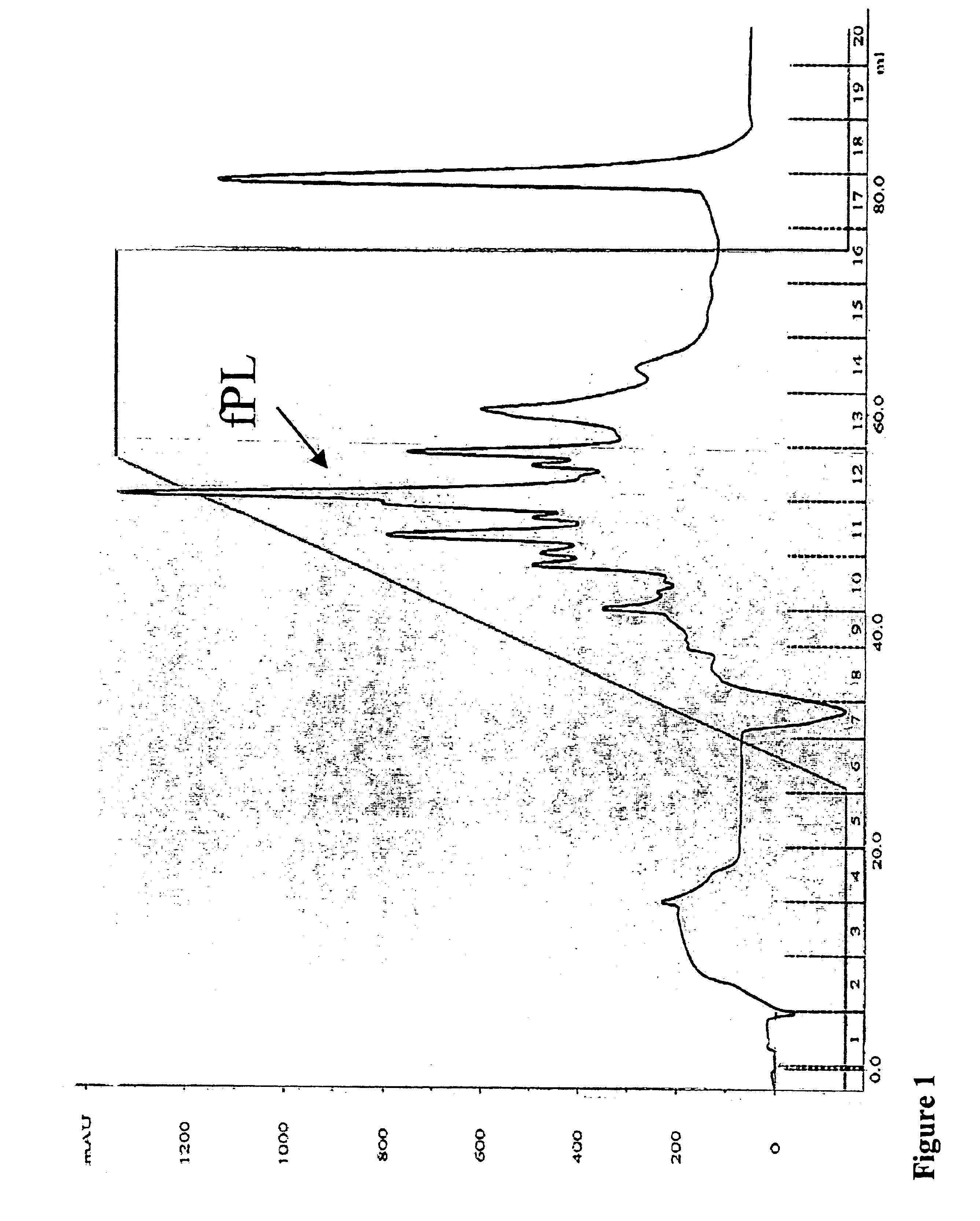Feline pancreatic lipase composition and method of preparing and using such composition
a composition and pancreatitis technology, applied in the field of biochemistry and medicine, can solve the problems of difficult diagnosis of disease, lack of sensitivity and specificity of pancreatitis assays in humans and dogs, and unreported purification of feline classical pancreatic lipas
- Summary
- Abstract
- Description
- Claims
- Application Information
AI Technical Summary
Benefits of technology
Problems solved by technology
Method used
Image
Examples
example 1
[0032]Purification of Feline Pancreatic Lipase (fPL) from Pancreatic Tissue
[0033]Pancreata were collected from cats sacrificed for unrelated research projects and stored frozen at −20° C. until further use. All standard laboratory equipment including the Buchner funnel was purchased from VWR Scientific, West Chester, Pa. All columns, chromatographic gels, pumps, fraction collector and UV-monitor were purchased from Amersham Biosciences, Uppsala, Sweden. The pH stat titration system (Metrohm 718 STAT Titrino) and the tissue grinder (Polytron PT-MR 2100) were purchased from Brinkmann Instruments, Westbury, N.Y. Supplies for electrophoresis were purchased from Invitrogen, Carlsbad, Calif., USA. All chemical agents were purchased from Sigma Chemicals, St. Louis, Mo., USA. The BCA protein assay kit was acquired from Pierce Chemical Company, Rockford, Ill., USA. Disposable size-exclusion chromatography columns and concentrators (Ultrafree centrifugal filter device; 10K) were purchased fro...
example 2
[0039]Lipolytic Activity Measurement during the Purification of Feline Pancreatic Lipase (fPL)
[0040]Lipolytic activity during purification was measured by a pH stat method using tributyrin as a substrate in the presence of colipase. For this purpose an acidic colipase preparation of feline colipase had been previously prepared. Briefly, 1 g of delipidated feline pancreatic extract was suspended in 50 ml 20 mM Tris-HCl, 3.3 mM CaCl2, 2 mM benzamidine, 5 mM 3-phenyl propionate, 1 mM PMSF (added in isopropyl alcohol), pH 8.0 and mixed at 4° C. for 2 hr. The mixture was centrifuged at approximately 12,000 g and 4° C. for 30 min and the precipitate was discarded. Lipase activity was measured and the pH adjusted to pH 2.0 using 6 N HCl. The solution was once again centrifuged under above conditions and the supernatant was saved. After measuring lipase activity the solution was adjusted to pH 5.0 using 2 N NaOH. After further centrifugation under above conditions aliquots of the supernatan...
example 3
[0041]Characterization of Purified Feline Pancreatic Lipase (fPL)
[0042]The molecular mass of purified feline pancreatic lipase was estimated by SDS-PAGE following manufacturer's instructions. The gel was stained with a Coomassie blue type stain. A more exact determination of the molecular mass was achieved using mass spectrometry performed by the Mass Spectrometry Laboratory, Department of Chemistry, Texas A&M University, College Station, Tex.
[0043]Specific absorbance of fPL was determined by measurement of the protein concentration of a serial dilution of feline pancreatic lipase in PBS, pH 7.2 with a known absorbance at a wavelength of 280 nm using a BCA protein assay (Smith et al., 1985).
[0044]N-terminal amino acid sequence for the first 25 amino acid residues was determined by Edman degradation using an automated amino acid sequence analyzer at the Department of Biochemistry, Purdue University, West-Lafayette, Ind.
PUM
| Property | Measurement | Unit |
|---|---|---|
| molecular mass | aaaaa | aaaaa |
| molecular mass | aaaaa | aaaaa |
| wavelength | aaaaa | aaaaa |
Abstract
Description
Claims
Application Information
 Login to View More
Login to View More - R&D
- Intellectual Property
- Life Sciences
- Materials
- Tech Scout
- Unparalleled Data Quality
- Higher Quality Content
- 60% Fewer Hallucinations
Browse by: Latest US Patents, China's latest patents, Technical Efficacy Thesaurus, Application Domain, Technology Topic, Popular Technical Reports.
© 2025 PatSnap. All rights reserved.Legal|Privacy policy|Modern Slavery Act Transparency Statement|Sitemap|About US| Contact US: help@patsnap.com



